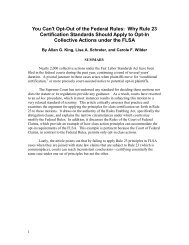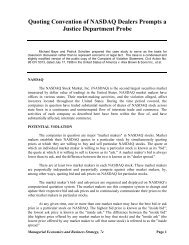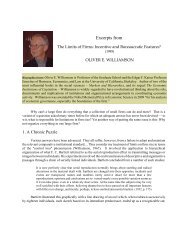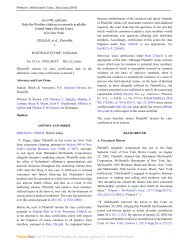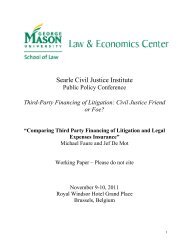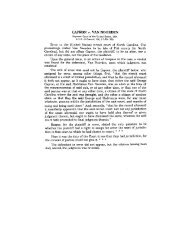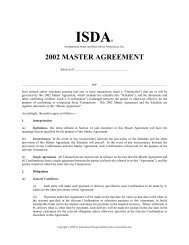Jelle Vlaanderen, et al., Occupational Benzene Exposure and the ...
Jelle Vlaanderen, et al., Occupational Benzene Exposure and the ...
Jelle Vlaanderen, et al., Occupational Benzene Exposure and the ...
Create successful ePaper yourself
Turn your PDF publications into a flip-book with our unique Google optimized e-Paper software.
<strong>Vla<strong>and</strong>eren</strong> <strong>et</strong> <strong>al</strong>.<br />
Egger’s test reve<strong>al</strong>ed no significant evidence<br />
for publication bias in <strong>the</strong> data available<br />
for AML, HL, NHL, ALL, or CLL<br />
[see Supplement<strong>al</strong> Materi<strong>al</strong>, Figure 4 (doi:<br />
10.1289/ehp.1002318)]. We observed evidence<br />
for bias for MM (p = 0.03), but Egger’s<br />
test became nonsignificant after exclusion of<br />
<strong>al</strong>l qu<strong>al</strong>ity of exposure assessment studies in<br />
category D (p = 0.72).<br />
Discussion<br />
We conducted a series of m<strong>et</strong>a- an<strong>al</strong>yses on<br />
occupation<strong>al</strong> cohort studies to assess <strong>the</strong> possible<br />
association b<strong>et</strong>ween benzene <strong>and</strong> lymphoid<br />
neoplasms. Using different dimensions<br />
of study qu<strong>al</strong>ity, we report evidence for an<br />
association b<strong>et</strong>ween occupation<strong>al</strong> benzene<br />
exposure <strong>and</strong> lymphoma subtypes MM, ALL,<br />
<strong>and</strong> CLL. For <strong>the</strong>se subtypes, mRRs increased<br />
with increasing study qu<strong>al</strong>ity, regardless of <strong>the</strong><br />
strategy that was used to assess study qu<strong>al</strong>ity.<br />
mRRs for NHL <strong>al</strong>so increased with increasing<br />
study qu<strong>al</strong>ity, <strong>al</strong>though this effect was less<br />
pronounced. We did not observe an association<br />
b<strong>et</strong>ween occupation<strong>al</strong> benzene exposure<br />
<strong>and</strong> HL. Importantly, with <strong>the</strong> exception of<br />
a chance finding, <strong>the</strong> increase in mRRs for<br />
NHL, MM, ALL, <strong>and</strong> CLL with increasing<br />
study qu<strong>al</strong>ity most likely reflects an actu<strong>al</strong><br />
underlying association with at least some of<br />
<strong>the</strong>se lymphoma subtypes.<br />
Because we observed mRR patterns consistent<br />
with a possible association b<strong>et</strong>ween<br />
benzene <strong>and</strong> <strong>al</strong>l lymphoma subtypes except<br />
HL, we form<strong>al</strong>ly explored quantitative exposure–response<br />
relations for NHL, MM, ALL,<br />
<strong>and</strong> CLL, including <strong>al</strong>l studies in qu<strong>al</strong>ity of<br />
exposure assessment category A (studies with<br />
quantitative estimates of benzene exposure)<br />
based on flexible m<strong>et</strong>a-regression an<strong>al</strong>yses<br />
(<strong>Vla<strong>and</strong>eren</strong> <strong>et</strong> <strong>al</strong>. 2009). The relatively limited<br />
number of studies in category A resulted<br />
in uncertain <strong>and</strong> unstable predictions of <strong>the</strong><br />
exposure–response curve for NHL, MM,<br />
<strong>and</strong> CLL (data not shown). For ALL, only<br />
one study in qu<strong>al</strong>ity of exposure assessment<br />
category A was available that precluded conducting<br />
a m<strong>et</strong>a-regression for this lymphoma<br />
subtype. Therefore, possible dose–response<br />
associations can only be discussed inform<strong>al</strong>ly<br />
on a study-by-study basis.<br />
Assessment of study qu<strong>al</strong>ity dimensions.<br />
We developed three different qu<strong>al</strong>ity dimensions<br />
that reflect <strong>the</strong> substanti<strong>al</strong> changes in<br />
diagnosis <strong>and</strong> categorization of lymphoid<br />
neoplasms over <strong>the</strong> last h<strong>al</strong>f century <strong>and</strong> <strong>the</strong><br />
h<strong>et</strong>erogeneity in occupation<strong>al</strong> cohort studies<br />
with regard to industry, sample size, <strong>and</strong> documentation<br />
of benzene exposure. The gener<strong>al</strong>ly<br />
higher RRs in <strong>the</strong> strata with studies that<br />
started follow-up in or after 1970 is consistent<br />
with b<strong>et</strong>ter qu<strong>al</strong>ity of lymphoma diagnosis in<br />
more recent years. The higher RRs are particularly<br />
noteworthy given that over<strong>al</strong>l benzene<br />
exposure was likely reduced in workplaces<br />
after 1970–1980. Ano<strong>the</strong>r secular trend in<br />
<strong>the</strong> qu<strong>al</strong>ity of cohort studies over time was <strong>the</strong><br />
greater use of incidence ra<strong>the</strong>r than mort<strong>al</strong>ity<br />
Table 4. mRRs (95% CIs) for AML <strong>and</strong> five lymphoma subtypes in cohort studies of workers exposed to<br />
benzene: stratification by exposure assessment qu<strong>al</strong>ity.<br />
Lymphoma subtype<br />
AML significance<br />
level a<br />
n studies<br />
n exposed<br />
cases<br />
AML A–D (<strong>al</strong>l studies) 21 217 1.68 (1.35–2.10)*<br />
A–C 10 108 1.73 (1.26–2.38)<br />
A–B 9 95 1.82 (1.25–2.66)<br />
A 6 71 2.32 (1.55–3.47)<br />
HL A–D (<strong>al</strong>l studies) 27 146 0.99 (0.83–1.19)<br />
A–C 5 16 0.99 (0.58–1.71)<br />
A–B 4 6 0.98 (0.36–2.67)<br />
A 4 6 0.98 (0.36–2.67)<br />
NHL b A–D (<strong>al</strong>l studies) 33 647 1.00 (0.89–1.13)*<br />
A–C 8 106 1.03 (0.70–1.51)*<br />
A–B 7 69 1.04 (0.63–1.72)*<br />
A 6 50 1.27 (0.90–1.79)<br />
MM A–D (<strong>al</strong>l studies) 26 284 1.12 (0.98–1.27)<br />
A–C 9 37 1.15 (0.74–1.79)<br />
A–B 8 28 1.48 (0.96–2.27)<br />
A 8 28 1.48 (0.96–2.27)<br />
ALL A–D (<strong>al</strong>l studies) 17 47 1.44 (1.03–2.02)<br />
A–C 4 11 1.26 (0.5–3.16)<br />
A–B 4 11 1.26 (0.5–3.16)<br />
A 1 5 2.80 (0.27–29.23)<br />
CLL A–D (<strong>al</strong>l studies) 18 111 1.14 (0.78–1.67)*<br />
A–C 8 61 1.38 (0.71–2.69)*<br />
A–B 7 53 1.54 (0.72–3.31)*<br />
A 4 43 2.44 (0.88–6.75)<br />
a A, quantitative exposure estimates for benzene; B, semiquantitative estimates of benzene exposure or quantitative<br />
estimates of exposures containing benzene; C, some industri<strong>al</strong> hygiene sampling results; D, qu<strong>al</strong>itative indication that<br />
benzene exposure had occurred. b NHL or lymphosarcoma/r<strong>et</strong>iculosarcoma (preferred NHL if <strong>the</strong> study reported both).<br />
*Significant evidence for b<strong>et</strong>ween study h<strong>et</strong>erogeneity (p < 0.1).<br />
mRR<br />
as end point (e.g., 91% of cohorts reporting<br />
CLL RRs with start of follow-up before<br />
1970 used mort<strong>al</strong>ity as <strong>the</strong> end point vs. 43%<br />
for studies with start of follow-up in 1970<br />
or later). It is possible that for less aggressive<br />
subtypes (e.g., CLL), subjects that died<br />
from o<strong>the</strong>r causes did not have lymphoma<br />
coded on <strong>the</strong>ir death certificate (Lin<strong>et</strong> <strong>et</strong> <strong>al</strong>.<br />
2007). However, cross-stratification of results<br />
suggested that stratification by period of<br />
follow-up explained more of <strong>the</strong> observed<br />
h<strong>et</strong>erogeneity than stratification by mort<strong>al</strong>ity/incidence<br />
(data not shown). Although it<br />
has been suggested that <strong>the</strong> RR for leukemia<br />
subtypes observed in occupation<strong>al</strong> studies<br />
might decrease with prolonged follow-up time<br />
(Richardson 2008), we found only modest<br />
evidence for this phenomenon for lymphoma<br />
subtypes. Substitution of <strong>the</strong> most recent RRs<br />
with those of previous updates did not materi<strong>al</strong>ly<br />
change <strong>the</strong> results (data not shown).<br />
Because <strong>the</strong> association b<strong>et</strong>ween benzene<br />
<strong>and</strong> AML is established, we argue that a wellconducted<br />
large epidemiologic study on benzene<br />
<strong>and</strong> hemato- <strong>and</strong> lymphopoi<strong>et</strong>ic cancers<br />
should find such an association. If at least<br />
some evidence of association is not found,<br />
one could argue that <strong>the</strong>re must be known<br />
or unknown m<strong>et</strong>hodologic limitations in <strong>the</strong><br />
study design. Such studies would by extension<br />
most likely be noninformative regarding <strong>the</strong><br />
association b<strong>et</strong>ween benzene <strong>and</strong> lymphoid<br />
neoplasms. Natur<strong>al</strong>ly, one should re<strong>al</strong>ize that<br />
a failure to find evidence for an association<br />
could <strong>al</strong>so be <strong>the</strong> result of insufficient statistic<strong>al</strong><br />
power. However, in our m<strong>et</strong>a- an<strong>al</strong>yses we<br />
observed that <strong>the</strong> strong increase in mRRs for<br />
AML with increasing AML significance levels<br />
was gener<strong>al</strong>ly par<strong>al</strong>leled by increasing mRRs<br />
in lymphoma subtypes. In o<strong>the</strong>r words, studies<br />
that reported higher (<strong>and</strong> more significant)<br />
RRs for AML gener<strong>al</strong>ly <strong>al</strong>so reported higher<br />
RRs for NHL, MM, ALL, <strong>and</strong> CLL.<br />
The qu<strong>al</strong>ity of exposure assessment has<br />
a large impact on <strong>the</strong> ability of an epidemiologic<strong>al</strong><br />
study to identify modest increased<br />
RRs. The relevance of our qu<strong>al</strong>ity of exposure<br />
assessment approach was illustrated with<br />
<strong>the</strong> strong increase in mRRs for AML with<br />
increasing qu<strong>al</strong>ity of exposure assessment.<br />
This trend provides support for our assumption<br />
that studies that conducted a more<br />
d<strong>et</strong>ailed benzene exposure assessment likely<br />
provide higher over<strong>al</strong>l qu<strong>al</strong>ity of evidence<br />
for <strong>the</strong> potenti<strong>al</strong> association of benzene with<br />
adverse he<strong>al</strong>th outcomes. Although one would<br />
expect that <strong>the</strong> study qu<strong>al</strong>ity indicators for<br />
AML significance level <strong>and</strong> qu<strong>al</strong>ity of exposure<br />
assessment to be highly correlated, this<br />
is not necessarily <strong>the</strong> case. For instance, we<br />
did observe five studies in <strong>the</strong> lowest category<br />
qu<strong>al</strong>ity of exposure assessment (D) that still<br />
reported a significant increased RR for AML,<br />
<strong>and</strong> we observed two studies from qu<strong>al</strong>ity<br />
164 v o l u m e 119 | number 2 | February 2011 • Environment<strong>al</strong> He<strong>al</strong>th Perspectives




